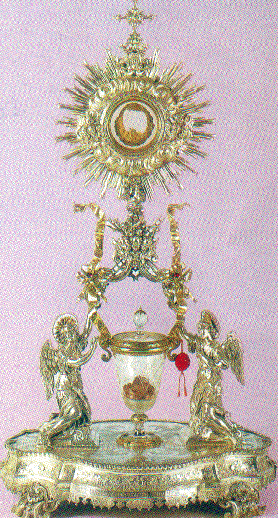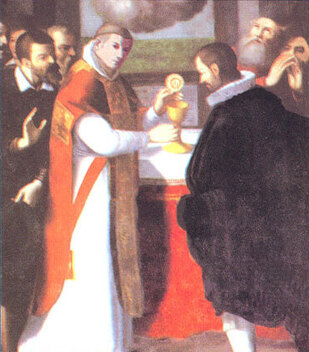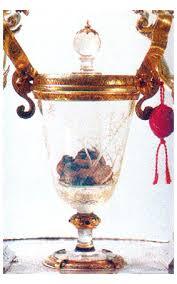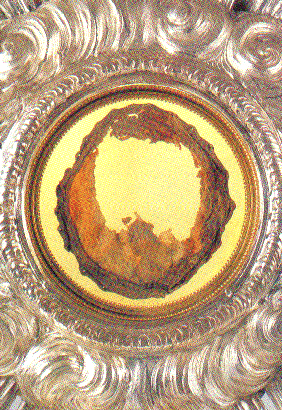Missionaries of the Blessed Sacrament
The Eucharistic Miracle of Lanciano, Italy

|
In the city of Lanciano, Italy, around the year 700 of Our Lord there was a priest of the order of St. Basil who, though learned in the sciences of the world, was ignorant in ways of God, and was not strong in his faith. He was plagued by a doubt as to whether the consecrated Host was truly the Body of Christ, and the consecrated wine truly His Blood. He had difficulty believing in the mystery of transubstantiation (the miraculous changing of the bread and wine into the Body and Blood of Christ).
One morning, as he was celebrating Mass, he had already said the most holy words of consecration ("This is My Body..., This is my Blood..."), as Jesus had taught it to his Apostles, his doubts and errors weighed upon him more heavily than ever. By a most singular and marvelous grace, he saw the Bread changed into Flesh and the wine into Blood.
Today twelve centuries after the miraculous occurrence it remains intact, a sustained miracle! Upon a superficial examination, the Host of Flesh, which is still in one piece and has retained the dimensions of the original "Large Host", has a fibrous appearance and a brown color, which becomes light-reddish if one places a light in the back of the Ostensorium. Official Position of the Catholic ChurchLocal Church and Vatican official have authenticated the Eucharistic miracle on many occasions since the middle ages. In 1672, Pope Clement X declared the altar of the Eucharistic Miracle a privileged altar on all Mondays of the year. In 1887, the Archbishop of Lanciano obtained from Pope Leo XIII a plenary indulgence in perpetuity to those who visit the Church of the Miracle during the eight days preceding the annual feast day, which falls on the last Sunday in October. Scientific StudiesA rigorous scientific analysis was performed in 1970-71 by Professor Dr. Odorardo, University Professor in anatomy and pathological histology and in chemistry and clinical microscopy, Head Physician of the United Hospitals of Arezzo. Prof. Linoli was assisted by Prof. Dr. Ruggero Bertelli, a Professor Emeritus of anatomy at the University of Siena.
Science, when called to testify, has confirmed what we have believed in Faith and what the Catholic Church has taught for the last 2,000 years; echoing the words of Christ, "My Flesh is real food; my Blood real drink. Whoever eats My Flesh and drinks My Blood dwells continually in Me and I dwell in him."-John 6:56-57
Miracles of the Eucharist Throughout the WorldReunion Island, Indian Ocean (Property of France) – 1902Fr. Lacombe, a priest at St. Andrew's Catholic Church exposed the Blessed Sacrament for 40 hours devotion. During the Holy Sacrifice of the Mass, in which Our Lord remained exposed in the Monstrance, Fr. Lacombe looked up to behold the face of Christ in Agony exposed in the Monstrance. Fearing what he was seeing was an optical illusion, he said nothing, but could not banish the image from his thoughts. After Mass, a man asked Father to bless a medal. Wanting to see if the image of Christ in the Host was an illusion, Father sent the man to look at the Host in the Monstrance. The man hurried back, crying that he has seen the face of a Man in the Monstrance. The altar boys, who Fr. Lacombe had sent to view the Host in the Monstrance, returned in amazement with the same reports. A little girl, who also beheld the face, later said, "I cannot forget what I have seen, I will always remember the Face of Our Lord... it has made an indelible mark on my life." Word of the miracle of the Holy Face of Christ spread quickly across the island. People flocked to the Church to see the Face of Christ in the Monstrance. Faverney, Burgundy, France – Pentecost Sunday 1608 (Notre Dame de la Blanche)It was a glorious feast of the town, and Dom Garnier had erected an especially magnificent repository for the Blessed Sacrament. At 3:00 a.m. of the feast, Dom Garnier returned to the Church and saw a glow around the chapel in which the Blessed Sacrament was exposed. Fearing the Church was on fire, he ran to the nearby Benedictine monastery for help. Accompanied by several monks, they returned to the Church and opened the door to witness a miracle. The Monstrance was suspended in mid-air! The stone, which was previously underneath the Monstrance, lay in three fragments on the floor, surrounded by the broken remains of the altar and candles. The Monks, who had fallen away in belief and practice, fell to their knees in adoration of the Sacred Host, Who they recognized as their Lord and Savior. This miracle inspired many conversions of those who had fallen away from Jesus and was declared valid by the Bishop within a few months. Bawol, Poland 1264It was a very turbulent and trying time in Poland's history, with many people falling victim to the dreaded Black Plague that stalked Europe. The population was depleted, and religious standards changed after the loss of older churchmen. People were devastated by the loss of family and friends, and the overall outlook was hopeless. It was in these trying times that a strange phenomenon arose from the marshy swamps near the village of Bawol, Poland. Nobody knew what to make of the arresting rays of light and the lightning bolts that ran across the sky. After the strange lights were first seen, people began visiting the spot to see who or what was causing the amazing light that nightly lit up the sky. During this miraculous occurrence, news reached Bawol that someone had broken into a church in Krakow and stolen the pyx containing the Most Holy Eucharist. The bishop entreated the people to pray and fast for the safe return of the Sacred Host, but was fearful that the thief had desecrated the Real Presence of Jesus. Hearing of the mysterious lights emanating from the swamp, the Bishop led a procession to the site. The people dug into the marsh and found the pyx, which contained the Blessed Sacrament, perfectly preserved amidst the slime and filth of the swamp. After the Sacred Host was restored to the Krakow church, the mysterious lights stopped. King Casimir the Great had the swamp drained and erected a magnificent church, which he dedicated as Corpus Christi, the Body of Christ. Aninon, Spain, 1300The church was obliterated by fire, and upon first inspection, it appeared that everything was destroyed–even the tabernacle and main altar. But the pall and corporal that covered the Sacred Hosts in the tabernacle were only burned in a few places. Five of the Hosts were bleeding and one of the Hosts was fixed to the pall. The people constructed a new church to honor the miraculous Hosts. People flocked to the grand new church to adore the miracle of the Eucharist. Even after the first miracle, the Bishop saw fresh blood soaking the corporal, which also continued to emit a divine fragrance. Both the pall and corporal have remained intact throughout the years with no sign of decay. On November 23, 1613 the Vicar General of Tarazona approved the miracle. Viversel, Belgium, Abbey of Herkenrode, 1317A priest of the parish went to administer last rites to a dying parishioner. While hearing the dying person's confession, the priest left his kit, which contained holy oils and the Blessed Sacrament, unattended outside the patient's room. Another villager, aware that the priest was occupied, snuck into the house and began rustling through the priest's kit. He lifted out the pyx containing the Sacred Hosts, but when he took Our Lord in the Blessed Sacrament out, the Sacred Hosts immediately started bleeding. Fearing that God would strike him down for such an act, the villager fled from the scene. Having finished hearing the confession of the dying patient, the priest went to fetch his kit, so as to give Holy Communion for the last time. Upon opening the Kit, he discovered the bloodied Hosts, and ran to consult with the pastor. They gave the bleeding Hosts to Fr. Simon, an abbott. While the priest was carrying the miraculous treasure to the abbey, voices of angels were heard, as well as the shrieking of demons. Animals in the fields bowed their heads in homage to the Eucharistic King. Before Mass at the abbey, the Sacred Hosts were placed on the altar. At this time, monks present witnessed the face of Christ, crowned with thorns, and they all testified to having seen the same vision. There have been many accounts of divine intervention and supernatural occurrences following this miracle. Santarem, Portugal, mid-13th centuryA woman of Santarem, upset by the perceived infidelity of her husband, desperately sought the counsel of a sorceress. In exchange for a consecrated Host, the sorceress promised to restore the affections of the woman's wayward husband. Although the woman was distressed by her marital situation, she realized that such an action was dreadfully wrong, and a sacrilege against the Real Presence of Our Lord in the Most Holy Eucharist. Despite her trepidation, the woman went to Mass and received, but did not consume, the Sacred Host. After hurrying from the church, she placed the Most Blessed Sacrament in her kerchief. Intent on her mission, the woman did not notice that the Host had started to bleed profusely. Another villager worried that the woman herself was injured, and drew the blood to her attention. Horrified that the Host was bleeding, she rushed home and placed the Blessed Sacrament in a trunk. In the middle of the night, the woman and her husband were awakened by the rays of bright light emanating from the trunk. Other townspeople came to the house and also beheld the miracle. The parish priest brought the miraculous Host back to the church in a wax container and placed it in the tabernacle. This was not the end of the miracle of Santarem, however: when the priest again opened the tabernacle, the wax container was broken, and instead a crystal container held the Blood of the Host! The church which contained the Sacred Host has been re-named the Church of the Miracle. Pezilla-La-Riviere, France – 1793During the violence and anti-Catholic furor of the French Revolution several brave French citizens took the Blessed Sacrament from their Church and kept the Real Presence of Jesus in their homes. The French government was enforcing a ban against Catholicism at the time, and even sold Churches and their sacred contents! Aware that their church was about to be sold, Rosa Llorens and Jean Bonafos went in and retrieved the Sacred Hosts from the tabernacle. If they had been caught, death would have been nearly certain. Despite the obvious danger, Rosa welcomed fellow brave Catholics who wished to adore Jesus in the Most Blessed Sacrament. The persecution of Catholics increased rapidly during the Reign of Terror, and many of the faithful suffered great losses of home and even life. Amidst this mayhem and persecution, the homes of Rosa Llorens and Jean Bonafos miraculously escaped unscathed, protected by the Divine Presence of Jesus in the Most Holy Eucharist. Erding, Bavaria (Present day Germany) – 1417A poor farmer of Erding had no food for his family, no matter how much time and effort he put into working his fields. A fellow farmer, who was quite successful, told him that the secret to his success was having the Blessed Sacrament in his home. The poor farmer, knowing nothing about proper veneration or respect of the Sacred Eucharist, viewed it merely in terms of possessing a charm that could bring good fortune. At Mass on Holy Thursday he went to Communion but did not consume the Sacred Host, and instead removed it from his mouth and placed it in a cloth. Although the farmer was not at all aware of the serious sin he was committing, he experienced a great deal of fear at the thought of his action. He deliberated, and asked himself about the consequences of what he had done. He honestly believed that the Presence of the Sacred Host in his home would cause the fortune of his family to change for the better. Nonetheless, he was plagued by a feeling that his actions were dreadfully wrong. His conscience finally won the battle inside of him, and he turned to go back from the Church and to confess his sin. As he was turning, the Sacred Host fell from his hand, floated in the air, and landed on the ground. The farmer began to search desperately for the Blessed Sacrament but could not find any trace of it. After his search, the farmer hurried back to the Church and immediately told the priest what had transpired. Accompanied by many villagers, they went back to the scene of the miracle. While still quite a ways away the priest could see the Eucharist, shining white, on the ground. When the priest bent to pick up the Host, it again flew into the air, was suspended and fell to the ground and disappeared. The priest relayed news of this event to the Bishop who went himself to the site. He, too, bent to retrieve the Sacred Host from the ground, but it again flew into the air and was suspended for an extended period of time, then floated to the ground. After this third and final miracle adoration and veneration of Jesus in the Blessed Sacrament increased dramatically and the people were awestruck by the miracle they had witnessed. To make reparation for the sins against our Eucharistic Lord, people of the town erected a beautiful Church. Avignon, France – 1433The Sorgue river in Avignon, France was heavily flooded in November of 1433. The waters rose steadily and reached a dangerous height. Along the teeming Sorgue, the Blessed Sacrament was exposed perpetually in a little church. The Gray Penitents of the Franciscan order were certain that the little church and had been destroyed by the raging waters. Fearing that the Blessed Sacrament would be destroyed as well, two friars rowed to the Church. To their astonishment, although water around the church was 4 feet high, a pathway from the entrance to the altar was perfectly dry! Jesus in the Blessed Sacrament, our sovereign King, was unscathed! The pathway from the entrance to the altar called to mind the parting of the Red Sea in Moses' time, for all along the sides of the Church, water steadily rose. Despite the surrounding flood, the pathway remained completely dry, untouched by even a drop of water. Amazed by what they were seeing, the Friars had others from their order come to the Church to verify the miracle. On that day our Eucharistic Lord was victorious over the raging water. Turin, Italy – 1453Turin was besieged by the armies of Piedmont, and soldiers ransacked and pillaged throughout the city-state. A Church in the village of Exilles was plundered by one of these soldiers, and he grabbed everything he could cram into his sack. One of the things he stole was a monstrance, with the Sacred Host still inside. The soldier threw the sack, which also contained the monstrance, onto his donkey. The man became enraged when the sack kept falling off the donkey's back, and began to furiously beat the animal. By this time, they were surrounded by villagers, who were distressed by the soldier's actions. All of a sudden, the sack fell to the ground, and its contents were strewn about the ground. The monstrance caught the attention of all who were present, and it slowly rose into the air, suspended ten feet above the ground. A priest was among the crowd, and hastened to find the bishop. The bishop immediately returned to the site of the miracle, accompanied by many priests. Upon the bishop's arrival, the monstrance opened and fell to the ground, leaving the Sacred Host still aloft and surrounded by a radiant light. The bishop began chanting Latin hymns, and was joined by the townspeople. During the hymns, the Host slowly descended, and landed in the outstretched chalice held by the bishop. People from all over Italy and Europe began coming immediately to venerate the Miracle of Turin. Eucharistic Miracles – SaintsSt. Catherine of Siena was invited to drink the Precious Blood of Jesus, which flowed from His side. After drinking from the Fountain of His Precious Blood, she could not eat or drink anything more. For seven years before her death she lived on no food but Our Lord in the Eucharist. She was not hungry, but remained active and strong. St. Juliana Falconieri, foundress of the Servite nuns, fasted so rigorously throughout her life that she was unable to even receive Jesus in the Most Blessed Sacrament on her death bed. She begged the priest to bring the Eucharist near, so that she could at least be next to Jesus. When he brought the Lord to her, St. Juliana wanted to kiss Him, but the priest would not allow her to. She then asked for a corporal (holy cloth) to be placed on her chest, over her heart, so that Jesus could be placed there for a moment. The priest agreed. As soon as the Sacred Host was laid on her chest, Our Lord in the Eucharist disappeared! And St. Juliana, having been united with her Love, died–her face radiant with joy. The priests and sisters fell to their knees at this miracle. When the Sisters later prepared her body for burial, they found on her breast–where Jesus had been placed–an outline of the Crucified Christ, encircled by the Host. St. Catherine of Genoa was a daily communicant, a special grace at the time in which she lived. During Advent and Lent she lived without food. She was sustained by the Eucharist and salt water alone. ReferencesJoan Carroll Cruz. Eucharistic Miracles: and Eucharistic Phenomena in the Lives of the Saints. (TAN: Rockford, IL, 1987). Bob and Penny Lord. This is My Body, This is My Blood: Miracles of the Eucharist, Vol. I. (Journeys of Faith: Morrilton, AR, 2003). Bob and Penny Lord. This is My Body, This is My Blood: Miracles of the Eucharist, Vol. II. (Journeys of Faith: Morrilton, AR, 1994). |
ADDRESS
Missionaries of the Blessed SacramentP.O. Box 1701
Plattsburgh, NY 12901, USA
CONTACT
Phone: (518) 561-8193
E-mail: ACFP2000@aol.com
Copyright 2000-2025 Missionaries of the Blessed Sacrament. All rights reserved.



